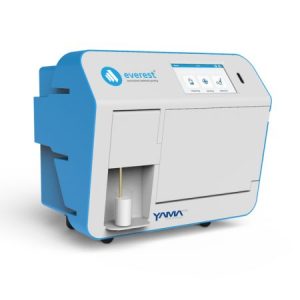The dairy industry has always been a cornerstone of agriculture, providing essential nutrition to millions worldwide. However, the demands on this industry have changed dramatically in recent years, driven by growing consumer expectations for quality, safety, and sustainability. As a result, modernizing the dairy sector has become a necessity, not just a choice. One of the key tools facilitating this transformation is the milk analyzer. In this blog, we start with the importance of milk analyzers, how they work, and the value they bring to the dairy farmer and processor in terms of quality control, efficiency, and profitability.
Introduction to Milk Analyzers
A milk analyzer in India is a device used in the dairy industry to measure various properties of milk quickly and accurately. These devices are equipped with advanced sensors and algorithms to assess critical parameters such as fat content, protein levels, lactose concentration, solid-non-fat (SNF) content, pH, and somatic cell count. The data generated by milk analyzers help dairy farmers, processors, and quality control teams to make informed decisions throughout the milk production and processing stages. With the ability to deliver precise results within minutes, milk analyzers play an essential role in ensuring that milk meets the desired quality standards before it reaches the consumer.

Importance of Quality Control in Dairy
Quality control is a critical aspect of the dairy industry. Milk and dairy products are highly perishable and susceptible to contamination, which can affect their safety and nutritional value. Ensuring consistent quality helps maintain consumer trust, prevents health risks, and reduces product recalls. Milk analyzers enable real-time quality monitoring, allowing dairy producers to detect deviations in milk composition early in the supply chain. This immediate insight helps in identifying issues such as adulteration, spoilage, or nutritional deficiencies, thus safeguarding the quality and safety of dairy products.
How Milk Analyzers Work
Milk analyzers employ a variety of technologies to measure milk components accurately. Some of the common technologies used include:
- Infrared Spectroscopy (IR): Infrared spectroscopy is widely used for analyzing milk composition. When milk is exposed to infrared light, different components (like fat, protein, and lactose) absorb light at specific wavelengths. The analyzer detects these absorption patterns and calculates the concentration of each component based on known standards.
- Ultrasound Technology: Some milk analyzers use ultrasonic waves to measure fat content. Ultrasound waves travel through the milk, and the speed of these waves varies depending on the fat content, allowing the analyzer to determine the concentration accurately.
- Flow Cytometry: For somatic cell counting, flow cytometry technology is employed. It works by staining the cells in the milk sample and passing them through a laser beam. The laser detects the number and type of cells, providing a measure of milk quality and helping to identify potential mastitis infections in dairy cows.
By combining these technologies, milk analyzers can provide a comprehensive profile of milk quality within minutes. This rapid analysis allows for immediate decision-making, enabling proactive quality management.
Benefits for Dairy Farmers and Processors
Implementing milk analyzers offers numerous advantages for dairy farmers and processors, driving significant improvements in productivity, quality, and profitability.
- Increased Productivity: By providing instant feedback on milk composition, milk analyzers help farmers optimize their feeding strategies, manage herd health, and improve milk yields. For processors, this data allows for better management of production processes, leading to more efficient operations.
- Reduced Waste: With real-time monitoring of milk quality, dairy producers can quickly identify and address any issues that may compromise product quality. This proactive approach minimizes waste by preventing the processing of substandard milk, thus reducing the cost associated with discarded products.
- Enhanced Profitability: Accurate milk analysis ensures that farmers are fairly compensated based on the quality of the milk they produce. Processors also benefit from better-quality raw materials, which results in higher-quality end products that can command premium prices in the market.
- Improved Product Consistency: Consistency is a crucial factor in maintaining brand reputation in the dairy market. Milk analyzers help ensure that every batch of milk meets the required specifications, leading to uniformity in the final dairy products, such as cheese, yogurt, and butter.
Regulatory Compliance and Standards
The dairy industry is heavily regulated, with stringent standards for milk quality and safety. Regulatory bodies require compliance with specific guidelines regarding milk composition, somatic cell counts, and microbial contamination levels. Milk analyzers are invaluable in helping dairy businesses meet these regulatory requirements. They provide accurate and reliable measurements that can be used as documentation to demonstrate compliance with national and international standards.
Moreover, some milk analyzers are designed to adhere to the guidelines set by the International Dairy Federation (IDF), the Codex Alimentarius, and other regulatory agencies. By ensuring that milk quality is consistently monitored, dairy producers can avoid penalties and maintain their market access, both locally and internationally.
Conclusion
Milk analyzers are playing a pivotal role in modernizing the dairy industry by enhancing quality control, optimizing productivity, and ensuring regulatory compliance. These devices provide a cost-effective and efficient solution for dairy farmers and processors to maintain high standards and improve profitability. As the dairy industry continues to evolve, the adoption of milk analyzers will undoubtedly remain a key driver of progress, helping to meet consumer expectations and regulatory demands while contributing to a more sustainable and profitable future for dairy producers.
Embracing the use of milk analyzers can be a game-changer for those in the dairy sector, providing the tools necessary to thrive in an increasingly competitive and quality-focused market.



 :
:









